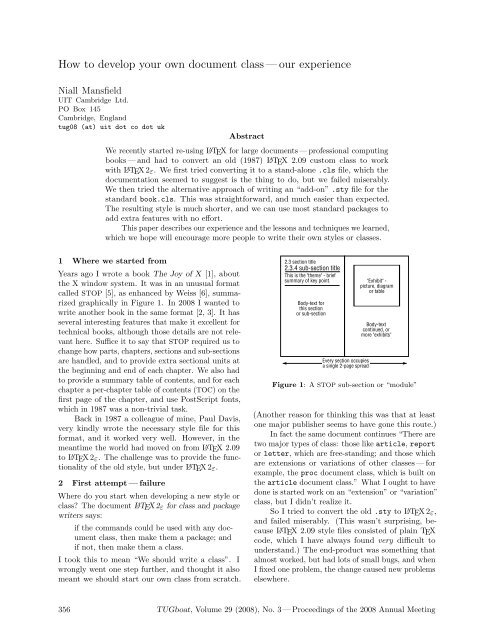The Communications of the TEX Users Group Volume 29 ... - TUG
The Communications of the TEX Users Group Volume 29 ... - TUG
The Communications of the TEX Users Group Volume 29 ... - TUG
You also want an ePaper? Increase the reach of your titles
YUMPU automatically turns print PDFs into web optimized ePapers that Google loves.
How to develop your own document class—our experience<br />
Niall Mansfield<br />
UIT Cambridge Ltd.<br />
PO Box 145<br />
Cambridge, England<br />
tug08 (at) uit dot co dot uk<br />
Abstract<br />
We recently started re-using L A<strong>TEX</strong> for large documents — pr<strong>of</strong>essional computing<br />
books—and had to convert an old (1987) L A<strong>TEX</strong> 2.09 custom class to work<br />
with L A<strong>TEX</strong>2ε. We first tried converting it to a stand-alone .cls file, which <strong>the</strong><br />
documentation seemed to suggest is <strong>the</strong> thing to do, but we failed miserably.<br />
We <strong>the</strong>n tried <strong>the</strong> alternative approach <strong>of</strong> writing an “add-on” .sty file for <strong>the</strong><br />
standard book.cls. This was straightforward, and much easier than expected.<br />
<strong>The</strong> resulting style is much shorter, and we can use most standard packages to<br />
add extra features with no effort.<br />
This paper describes our experience and <strong>the</strong> lessons and techniques we learned,<br />
which we hope will encourage more people to write <strong>the</strong>ir own styles or classes.<br />
1 Where we started from<br />
Years ago I wrote a book <strong>The</strong> Joy <strong>of</strong> X [1], about<br />
<strong>the</strong> X window system. It was in an unusual format<br />
called STOP [5], as enhanced by Weiss [6], summarized<br />
graphically in Figure 1. In 2008 I wanted to<br />
write ano<strong>the</strong>r book in <strong>the</strong> same format [2, 3]. It has<br />
several interesting features that make it excellent for<br />
technical books, although those details are not relevant<br />
here. Suffice it to say that STOP required us to<br />
change how parts, chapters, sections and sub-sections<br />
are handled, and to provide extra sectional units at<br />
<strong>the</strong> beginning and end <strong>of</strong> each chapter. We also had<br />
to provide a summary table <strong>of</strong> contents, and for each<br />
chapter a per-chapter table <strong>of</strong> contents (TOC) on <strong>the</strong><br />
first page <strong>of</strong> <strong>the</strong> chapter, and use PostScript fonts,<br />
which in 1987 was a non-trivial task.<br />
Back in 1987 a colleague <strong>of</strong> mine, Paul Davis,<br />
very kindly wrote <strong>the</strong> necessary style file for this<br />
format, and it worked very well. However, in <strong>the</strong><br />
meantime <strong>the</strong> world had moved on from L A<strong>TEX</strong> 2.09<br />
to L A<strong>TEX</strong>2ε. <strong>The</strong> challenge was to provide <strong>the</strong> functionality<br />
<strong>of</strong> <strong>the</strong> old style, but under L A<strong>TEX</strong>2ε.<br />
2 First attempt — failure<br />
Where do you start when developing a new style or<br />
class? <strong>The</strong> document L A<strong>TEX</strong>2ε for class and package<br />
writers says:<br />
if <strong>the</strong> commands could be used with any document<br />
class, <strong>the</strong>n make <strong>the</strong>m a package; and<br />
if not, <strong>the</strong>n make <strong>the</strong>m a class.<br />
I took this to mean “We should write a class”. I<br />
wrongly went one step fur<strong>the</strong>r, and thought it also<br />
meant we should start our own class from scratch.<br />
Figure 1: A STOP sub-section or “module”<br />
(Ano<strong>the</strong>r reason for thinking this was that at least<br />
one major publisher seems to have gone this route.)<br />
In fact <strong>the</strong> same document continues “<strong>The</strong>re are<br />
two major types <strong>of</strong> class: those like article, report<br />
or letter, which are free-standing; and those which<br />
are extensions or variations <strong>of</strong> o<strong>the</strong>r classes—for<br />
example, <strong>the</strong> proc document class, which is built on<br />
<strong>the</strong> article document class.” What I ought to have<br />
done is started work on an “extension” or “variation”<br />
class, but I didn’t realize it.<br />
So I tried to convert <strong>the</strong> old .sty to L A<strong>TEX</strong>2ε,<br />
and failed miserably. (This wasn’t surprising, because<br />
L A<strong>TEX</strong> 2.09 style files consisted <strong>of</strong> plain <strong>TEX</strong><br />
code, which I have always found very difficult to<br />
understand.) <strong>The</strong> end-product was something that<br />
almost worked, but had lots <strong>of</strong> small bugs, and when<br />
I fixed one problem, <strong>the</strong> change caused new problems<br />
elsewhere.<br />
356 <strong>TUG</strong>boat, <strong>Volume</strong> <strong>29</strong> (2008), No. 3 — Proceedings <strong>of</strong> <strong>the</strong> 2008 Annual Meeting

















